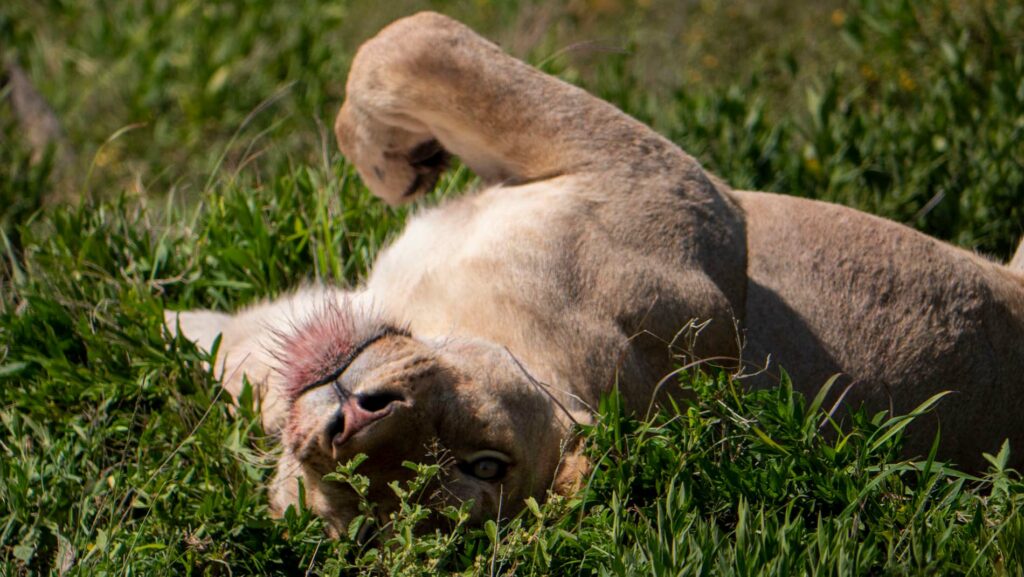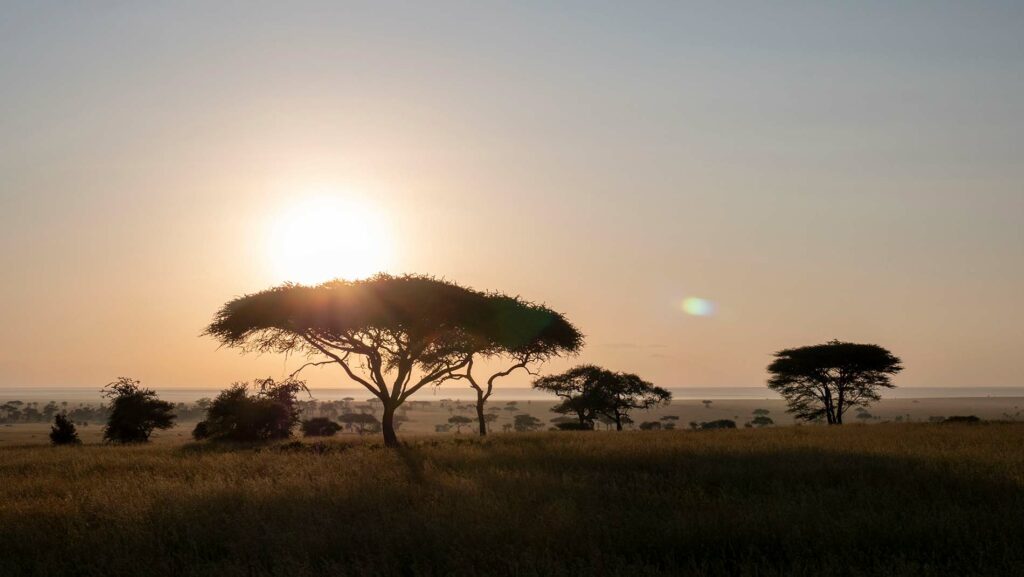If you are looking for an iconic safari in Africa, chances are you will end up in Serengeti National Park. World-famous because of the great migration, the many lions, and the steppes reaching beyond the horizon. Explore Africa travels into the Tanzania national park in collaboration with Makasa Safari in order to explore the endless grasslands.
Serengeti National Park
We have barely entered the Serengeti when the vultures start circling in the sky above us. “A sign there may be lions in the vicinity. They can smell free barbecue,” our guide Kaleby Macha tells us. The movements of the majestic bird are closely followed by other hungry creatures. While we proceed at a crawl, we see cruel brownish black heads with round ears appear from the grass in various spots: hyenas. “Incredibly smart animals. They use the vulture as their eyes in the sky and follow the birds straight to their meal. I am guessing they can smell the blood by now.”
Both animals follow the great migration, the natural phenomenon that the Serengeti is famous for. More than a million and a half wildebeest and 250,000 zebras follow the rains to eat the freshly grown grass. Their presence is a potential feast for the predators.
Killed pregnant wildebeest
It doesn’t take long before we find three lions, the blood still on their chins. They managed to kill a wildebeest that they are consuming now, at no more than a couple of yards from our Landcruiser. “This animal was killed tonight. You can see the cadaver is still fresh,” Kalebi explains. “They kill the animal by biting its throat, often that of a slow or weak animal, such as a cub, but in this case it was pregnant, to judge from its big belly.”
The lions aren’t planning to share their meal, and they drag the cadaver towards the taller grass to hid it and lie down to sleep. Arranged in a triangle. “This way, they are able to see danger from any angle and protect the meal,” Kalebi explains. The vultures and hyenas keep a close eye on the situation. Only after the lions abandon the cadaver will they be able to eat. “The lionesses can live on this for two days easily, and then they will go hunting again.” Patience is a virtue, still.
Article continues below.

Great Migration
The first groups of herbivores with their young have by now arrived from Ndutu. Enough prey to find for the lions, that cannot possibly miss their arrival. Yesterday, the clouds in the Serengeti started liberating their load and the animals instinctively know that they can find the freshest grass here, now. Wherever we look, we spot munching wildebeest and zebras. From right in front of our car until the distant horizon we see the black shadows and we can hear their characteristic bellowing. They do not seem impressed by the presence of the predators at a few yards’ distance, and calmly graze their meal.
They might look slightly silly, but the grazers have an essential function in maintaining the miracle of nature: without migration, no Serengeti, would be safe to say. Researcher Tony Sinclair discovered that because the wildebeest gnaw the grass short, there is less fuel for fires and shrubs and trees have the opportunity to grow. As a result, elephants, giraffes, and many bird species find enough to eat in the area: all thanks to the wildebeest.
But in the end, it’s all team work, our guide says. Because in the vanguard of the migration, we encounter thousands of zebras, so that the green expanse transforms into a blanket of black-and-white. The grazers all collaborate,” says Kalebi, “the zebra first eats away the higher grass, then the wildebeest follows for the shorter blades, followed by the antelope for the leftovers.”
Leopard
When we leave the migration behind and drive on to the fields with tall grass and more abundant trees, we finally grab the binoculars to search for a leopard. A tough job, because rendering himself invisible is one of the specialties of the animal, our guide tells us. I read in the Safari Guide that I should mainly look for strange branches bending inwards that may betray the dangling paw of a leopard. Even though we are watching the same tree, the guide and I see something different. While I see nothing but branches and leaves and redirect my binoculars towards the next tree already, Kalebi interrupts me and high-fives me with an enormous smile. “Found it.” After some instructions we have managed to distinguish the mighty animal as well, sleeping on an elevated branch between the leaves.
Where the lions tried in vain to hide their prey in the tall grass from vultures and hyenas, a leopard is a lot more inventive, Kalebi says, while we admire and observe the animal. “A leopard drags his prey up the tree with him, behind a dense canopy, so that vultures are unable to see the food from the sky.” Quite the performance, considering that an adult wildebeest may easily weight as much as 250 pounds. “Once such a killed prey is safe on top of a branch, the leopard clears off the blood with its tongue from the surrounding area, so that hyenas no longer smell it.” Isn’t that out of this world?
Empty battery
It’s gotten late. So it’s time to leave the leopard behind and to head to our accommodation: the luxurious Singing Grass. Easier said than done! We’ve made so many stops today for pretty views, the great migration, lions, elephants, giraffes, and special birds, that the battery of our car has given up on us. Great. We are stuck in the middle of nowhere, next to a leopard. So getting out is not an option.
In this type of situation, a good guide proves his value. Fortunately, Kaleby is one of them and he asks a different safari car to give ours a little kick start. “It’s a new car, so a few yards is enough already.” Within a minute we drive off again, as a matter of fact, over the steppes without any problems.
Article continues below.

Singing Grass: presidential suite
When we reach the compound, we watch a giraffe munching off the leaves of an acacia, as we enjoy a beer at the campfire. In the meantime, the setting sun slowly dunks the vast grasslands in darkness as we can hear the lions roaring in the distance. We get ready for the night as well. The four-guest tents of Singing Grass are presidential-suite size. A type of ‘camping’ nobody can be averse to: that is how splendid and luxurious this tent is, with a shower inside and out, a lounge area, walk-in-closet, and kingsize bed. At night, the hyenas lurch towards the kitchen tent. They can clearly be heard. After a while they give up.
The next day, our guide has arranged a new battery and we can go and discover the remaining 11,000 square miles of this beautiful nature reserve without worries.
Our visit to the Serengeti and stay at Singing Grass was arranged by Makasa Safari as a part of a ten-day safari in Tanzania. A stay at Singing Grass is possible from 1100 USD a night.


Recent Comments